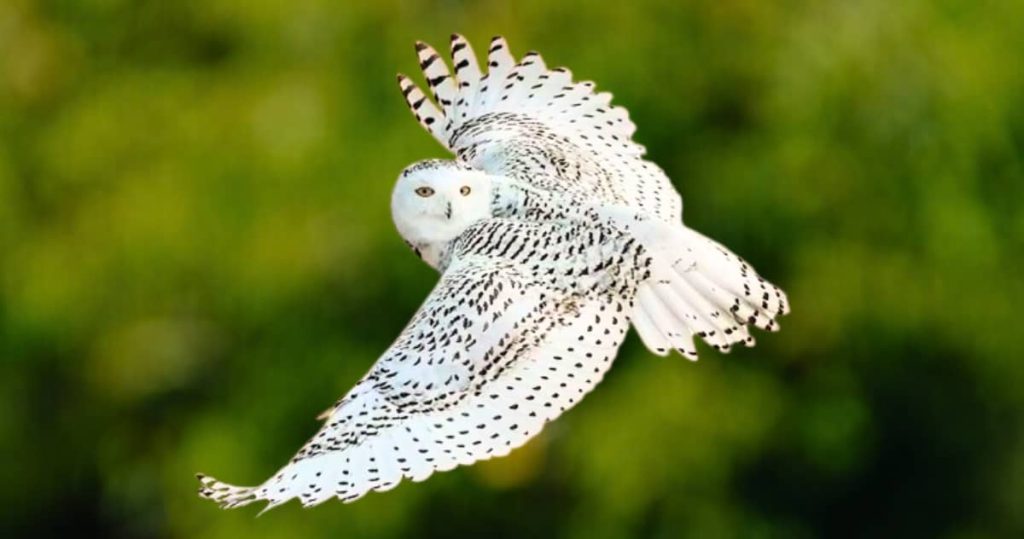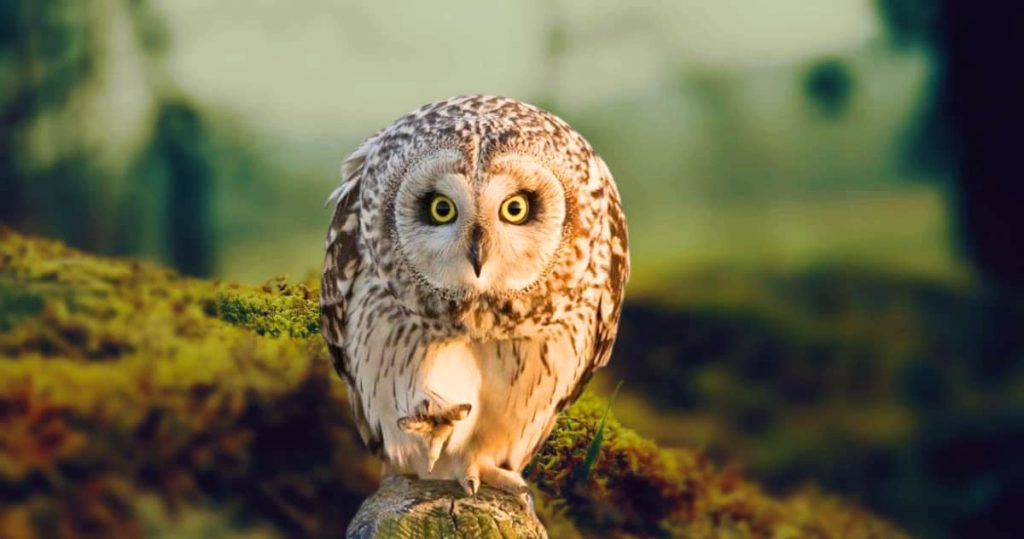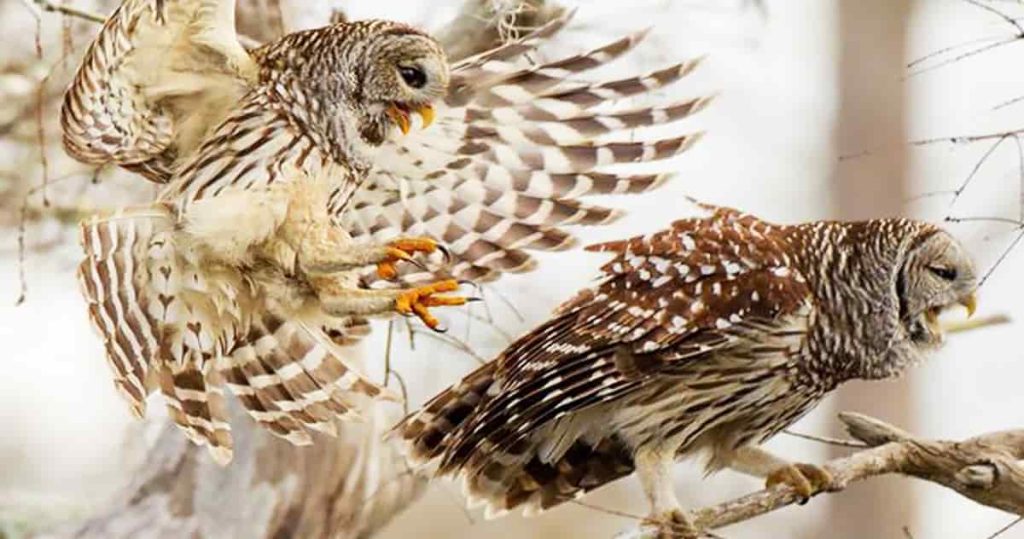
Owls are nocturnal birds of prey, so we know very little about them. Do owls migrate or hibernate? I will deliver the exact information in this article.
Currently, a total of 254 species of owls have been discovered, and so far, new information about owls is emerging daily.
Owls of different species can be seen to change their behavior given their species and habitat.
Let us say here that owls do not hibernate; several species of owls migrate, but not all species of owls.
I will describe in detail below which species of owls migrate and which species of owls do not migrate.
Contents
- 1 Do owls migrate or hibernate?
- 2 Do owls migrate?
- 3 Do owls hibernate?
- 4 Do owls migrate in the winter?
- 5 Do owls migrate in the summer?
- 6 Do owls fly south for the winter?
- 7 How do owls stay warm in the winter?
- 8 Migratory life
- 9 Unique feather characteristics
- 10 Sunbathing
- 11 Seeking a warm shelter
- 12 Group together
- 13 Unique blood vessels
- 14 Do snowy owls migrate?
- 15 Do short-eared owls migrate?
- 16 Do barred owls migrate?
- 17 Do great horned owls migrate?
- 18 Do barn owls migrate?
- 19 Do screech owls migrate?
- 20 How do Owls Survive in the Winter?
- 21 Do owls come out in the winter?
- 22 Do owls migrate south in the winter?
- 23 Do owls hibernate during the winter?
- 24 FAQs
- 25 Conclusion
Do owls migrate or hibernate?

Before learning which owls migrate, what is meant by migrate and hibernate? Or need to have a proper understanding of migration and hibernation. Let’s find out below:
Do owls migrate?
As mentioned earlier, several species of owls migrate. Several species of birds migrate to other areas to escape particularly severe winters, due to lack of food in particular seasons or during the breeding season, and return to their original habitat after spending several months there.
Do owls hibernate?
No species of owl hibernates. Certain species of animals, such as frogs, snakes, turtles, and snails, hibernate mainly. All these species go to safe shelters during the winter and do not do any physical activity or take any food during the winter season.
| Migratory owl | Partially Migratory owl | Non-Migratory owl |
| Snowy Owl | Boreal Owl | Barn Owl |
| Burrowing Owl | Collared scops Owl / Indian scops-owl | Great Horned Owl |
| short eared Owl | – | Barred Owl |
| Long-eared Owl | – | Tawny Owl |
| Northern Saw-whet Owl | – | Screech Owl |
Do owls migrate in the winter?

Not all species of owls migrate, mainly the species of owls that live in very cold areas and the species of owls that cannot tolerate the cold. Mostly, those species of owls migrate in winter to escape the severe cold.
Also, in winter, owls leave their area for several months due to a lack of food in several regions. Snowy owls are notable among all the owls known as migration owls. In addition, the list of migrating owls includes the burrowing owl, short-eared owl, long-eared owl, northern saw-whet owl, etc.
However, there are several species of owls specified as partially migratory owls. These species of owls may or may not change their territory at certain times of the year. Examples of partially migratory birds are boreal owls, collared scoop owls, etc.
Do owls migrate in the summer?
There can be several species of owls that migrate, usually in the winter. The migration of owls is not associated with summer.
However, some snowy owls are occasionally seen migrating during the summer. Owls migrate south from their habitat during the winter.
Snowy owls are used to living in colder regions; if ever snowy owls stay in an area where the heat gets too hot during the summer, they leave that area and move further north to colder areas.
Do owls fly south for the winter?

Several species of migratory owls live mainly in colder areas and move far south from their habitat during the winter season.
However, not all species of owls fly south during the winter. The main reason why migratory owls fly south in winter is because the southern region is warmer than the northern region during winter. That is why prey is readily available in southern regions and owls do not have to starve.
Snowy owls are highly migratory. Because in the northern regions where snowy owls live, survival during the winter is very difficult due to the severe cold. That’s why snowy owls are seen moving farther south from their habitats every year during the winter season.
How do owls stay warm in the winter?

Owls are accustomed to easily adapting to the area they live in, so they do a variety of things to keep themselves warm, whether it’s winter or monsoon.
Migratory life
Several species of owls live a migratory life to survive the harsh winters. During the winter season, they move to warmer areas and return to their original areas when the winter subsides.
Unique feather characteristics
Owls have many types of feathers on their bodies, which prevent the cold air from outside from hitting the owl’s body during the winter. All species of owls that live in colder regions have feathers all over their bodies and legs that help keep their feet warm.
Sunbathing
Although owls are nocturnal birds, they can often be seen basking during daylight hours if it is extremely cold. Owls can heat their bodies a lot by sunbathing.
Seeking a warm shelter
Owls often seek out warmer places when it gets really cold. At this time, owls can take shelter in man-made owl boxes, thickets of trees, and abandoned houses.
Group together

Owls tend to live solitary lives, but some species of owls can be seen in flocks during the winter. Many species of owls keep their bodies warm during the winter by huddling together.
Unique blood vessels
Owls have unique blood vessels in their legs that play an important role in keeping the owl’s body warm, as these blood vessels in owls’ legs regulate body temperature.
Do snowy owls migrate?
Snowy owls are mostly seen in the Arctic region, which is why this owl is called the Arctic owl.
This species of owl is counted as the only completely white owl species found in the world and for that, this owl is called the white owl. This species of owl is called snowy owl because it mainly lives in snowy areas.
Because this species of owl lives in the Arctic region, the region experiences severe winters in the winter, so they are recorded to lead migratory life flying more than 5,000 kilometers south of their habitat.
This species of owl is one of the migratory owls, they live a migratory life mainly to escape from severe winters and to meet the shortage of prey.
They mainly nest on the ground, their white feathers blend in with the snowy environment in such a way that they become difficult to spot easily.
Snowy owls belong to a large species of owl and prey most during daylight hours.
Do short-eared owls migrate?
Short-eared owls live in different areas of America, Europe, Asia, Africa, and Oceania.
Yes, short-eared owl migration, like snowy owls. This medium-sized owl has been recorded to travel 350 to 4,000 km from its habitat to lead a migratory life.
In comparison to other owls, this species of owl is more likely to be found during daylight hours. It is also a common owl species living everywhere except Australia and Antarctica.
They prefer to live and hunt in open areas, so they nest on the ground in dry or open areas.
Do barred owls migrate?

Barred owls are found in several regions of the United States, Canada, Mexico, etc.
These medium-sized owls are better named non-migratory owls. They are confined within 6 miles of their birthplace.
They differ from other owls by their brown-and-white-striped feathers and their brown eyes that look like black eyes.
This species of owl gives a distinctive call that has earned it the nickname Old Eight-Hooter.
They usually prefer to stay in forested areas, so their nests can be seen in large trees or dead trees.
Do great horned owls migrate?
The great-horned owl is seen in several regions of the United States, Canada, Mexico, Guatemala, Belize, Honduras, Colombia, Venezuela, Ecuador, Peru, Brazil, etc.
The great-horned owl is known as a large species of owl, but it is not a migratory owl. These species of owls are seen to roam within 1.5 square miles of their breeding grounds.
These species of owls look very aggressive, easily hunting animals larger than their weight.
These owls are identified for the two horn-shaped tufts of feathers on their heads. The yellow color of their eyes makes you think that it is a skilled bird of prey.
They are seen building nests in almost all areas, such as large trees, tree trunks, hills, isolated buildings, artificial platforms, etc.
Do barn owls migrate?
Apart from Antarctica, barn owls can be found on five continents: Asia, Africa, America, Australia, and Europe.
This medium-sized owl is not a migratory owl species. They are restricted to their specific area throughout the year. They hunt, nest, and raise young within 5 miles of their birthplace.
In the wild, this species of owl is known for spending the rest of its life with one mate.
This species of owl is the most commonly seen in the world and is also known for its white face feathers and love-shaped brown feathers.
These species of owls are more likely to live near humans and can even be found living easily in man-made structures.
Do screech owls migrate?
Eastern Screech-Owl, Western Screech-Owl, Northern Screech-Owl, Tropical Screech-Owl, and Cloud-Forest Screech-Owl A total of 27 subspecies of screech owls from the United States, Canada, Mexico, Costa Rica, Panama, Trinidad, Tobago, Bolivia, Peru, etc. can be found across the country.
These small species of owls are non-migratory; they roam within 2 miles of their birthplace, where they hunt, nest, lay eggs, and care for their young.
Due to the many subspecies of screech owls, their feather colors can vary, but gray or reddish-brown colors are more common.
They like to build nests in natural cavities, abandoned woodpecker nest holes, and tree trunks. In short, screech owls prefer burrow nesting. do eastern screech owls migrate
How do Owls Survive in the Winter?
Some species of owls can face a difficult time surviving in the winter, especially those that live in colder regions.
Owls can sometimes suffer from hypothermia due to extreme cold. However, the incidence of hypothermia is higher in wet owls during the monsoon than in the winter.
In many regions, food shortages are observed during the cold season, which is why some species of owls migrate during the winter season in search of food and escape from severe winters.
Owls’ feathers appear to have an important role in keeping the owl’s body warm in winter because the thick feathers resist the owl’s skin from being exposed.
Do owls come out in the winter?
Some species of black bears, ground squirrels, and bats hibernate in winter, but no species of owl hibernate.
Some species of owls leave their territories in winter and fly south; although owls are nocturnal, several species of owls are seen hunting during the day.
Due to the cold nights in winter, owl prey does not come out at night, which is why many species of owls hunt during the day in winter because prey is easily available during the day.
Owls’ feathers are positioned so that the outside air does not touch their skin, so cold air does not touch their skin in winter, which allows owls to roam easily in winter.
Do owls migrate south in the winter?
As mentioned earlier, several species of owls fly south for the winter, with the Snowy Owl at the top of this list.
Owls usually migrate during the winter; the north is colder during the winter and the south is less cold, so some species of owls move south to survive the harsh winter and find more food.
Several species of owls have adapted to their winter environment, choosing habitats where they can easily find prey and not areas that get too cold like snowy owls, so they don’t have as much trouble during the winter.
Do owls hibernate during the winter?
The process of hibernation is rarely observed in birds, but the poorwill, a small bird found in parts of the Americas and Mexico, goes into a state of torpor during severe winters.
A hibernation position is not observed in any species of owl. The body structure of owls, especially the different-shaped feathers, is ideal for protecting them from severe winters.
Also, several species of owls migrate to escape severe winters because the regions where the severe winters occur lack prey, which is why they are forced to migrate.
FAQs
Q. When do short-eared owls migrate?
Ans: Short-eared owls mainly migrate during the winter, but their migration may change depending on food availability, habitat, and breeding season.
Q. Are Owls Warm-blooded?
Ans: Like all birds and mammals, owls are warm-blooded birds.
Q. When do owls hibernate?
Ans: Owls do not hibernate like some other birds, they are active throughout the year and some owl species are migratory during the winter.
Q. Are owls migratory birds?
Ans: Although not all species of owls are migratory, some species of owls such as the snowy owl, and short-eared owl are migratory.
Conclusion
The information that I have delivered on “Do owls migrate or hibernate” has hopefully helped you learn something new about this beautiful bird.
The more you know about owls, the more it will surprise you. Their lifestyle seems no less than a mystery.
To preserve the ecological balance of the environment, we should save this bird from extinction.
By placing an owl box near our surroundings, we can do the smallest help for this species of bird to live a healthy life.